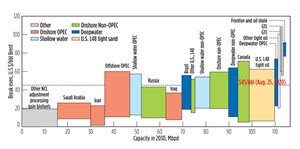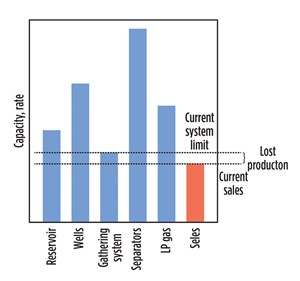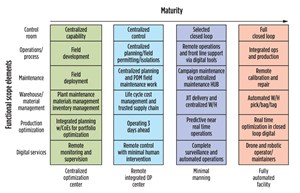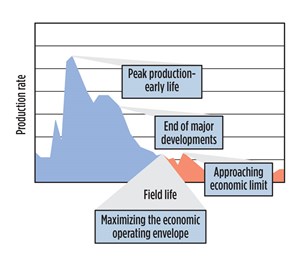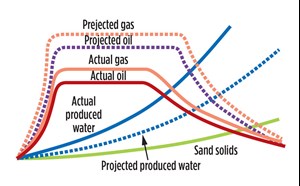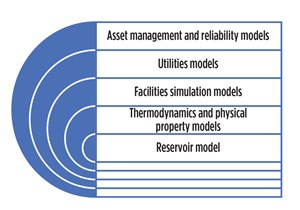Buy time, digitalize and transition
At current and forecast prices, much of the upstream world is uneconomic, with many oil companies obliged to cut capex and opex budgets significantly. Producers are now very focused on lowering costs and optimizing existing assets at lower flowrates. Production in many regions across the world is being reduced, where it is cost-negative on a variable cost basis, Fig. 1. Maintenance of many existing assets is also being reduced on those which are uneconomic, with some assets being considered for shut-in. The upstream industry must undergo large-scale portfolio and operating model adjustments to improve economics of marginal assets.
Given the scale of production, which is uneconomic at current and forecast oil prices, the industry, as a whole, needs to digitalize deeper and faster to boost its resilience and competitiveness. It’s no longer about the competitiveness of individual assets, but rather about competitiveness of the industry in general. New, more radical approaches are needed to drive out cost and capture revenue opportunities at scale, in order to remain competitive in the energy mix.
CHANGE PRIORITIES
Growing the top line always takes time. But do you have time? Maybe—but probably not in this business environment. This means survival hinges on three things:
- Short-term productivity and efficiency optimization, to buy time.
- Digitalization, to help maintain the short-term gains/cost-savings.
- Sustainability through portfolio management to position for longer-term success in the energy transition.
Considering the first two areas, the chart in Fig. 2 illustrates the main levers available for improving profitability and cash flow. However, only two of these levers are focused on driving fundamental change in the portfolio production core of assets, either through development of new capital projects, or improving existing assets. The remainder of the levers do not result in a fundamental change in the way assets are operated, to drive a more resilient or sustainable future.
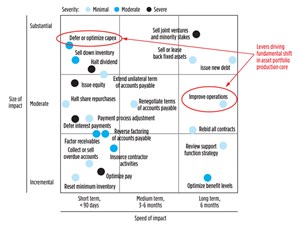
Priority areas for high impact and quick implementation. With economics of new capital projects under pressure, the most viable remaining lever of the two involves improving existing operations (see red highlights in Fig. 2). Improvement of operations entails the pursuit of value chain optimization to bolster competitiveness. Value chain optimization entails the agile optimization of fluids and other inputs with products and operations to reflect market demand and prices. More specifically, reservoir production potential is aligned and optimized with the gathering system, top-side processing constraints and market demand. And this should be achieved within the context of a highly efficient business operating model encompassing plant processing capabilities, governance and design rights, organizational model, operating processes, technology and talent strategy.
This is important, because today there is deep inefficiency in many business operating models, with many teams operating in their individual silos: 1) reservoir teams; 2) drilling teams; 3) facilities people; 4) well teams; and 4) commercial teams. Historically, these silos have been allowed to exist because of complex iterative work processes, disparate data sources and narrow point solution technologies. As a result, teams have been unable to converge around a unified, integrated, asset model digital twin for shared understanding and action.
However, through native integration with new, commonly accepted visualization tools and user interfaces, complex technologies and associated capabilities are becoming more readily usable and accessible by a wider base of users, with varying levels of expertise. In many instances, the myriad technologies running behind the scenes are becoming hidden to the user, thereby lowering the barriers to entry of certain roles. The outcome of this connectivity explosion is an improved efficiency of troubleshooting/optimization and more holistic and impactful decision-making.
Action plan—think big, start small, scale fast, drive adoption. Most asset owners and operators are involved in some aspects of value chain optimization, involving either asset optimization (of the reservoir of facilities) or supply chain optimization. However, few have integrated these activities in a holistic way. Furthermore, for many, there’s no coherent big picture or destination that they’re striving for. Many have started small or in an ad hoc manner, and they haven’t scaled fast. As a result, their initiatives are only “scratching the surface,” have died, or are hanging on by a thread.
Value chain optimization, by definition, requires thinking big. It takes a “systems thinking” approach that focuses on the way that a system’s constituent parts interrelate, how they work overtime and how it happens within the context of larger systems. The chart in Fig. 3 outlines this concept, with the current system constraint being the gathering system. Addressing the gathering system constraint means production can be increased to meet the reservoir constraint. And remember—all this changes over time, as the field matures and secondary and tertiary recovery are needed.
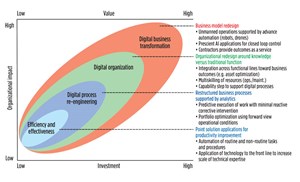
Industry has been relatively successful in achieving productivity improvements from point solution technology applications that drive efficiency and effectiveness. However, many assets have reached the “point of diminishing returns” in the pursuit of optimization benefits using conventional business models. Using the example above, imagine that the constraints have been optimized to the fullest extent possible. To reach the next horizon of value, these assets must undergo digital process re-engineering, digital re-organization and digital business transformation, Fig. 4.
Remote operations centers (ROCs) aren’t all made the same. Depending on the current operational excellence and digital maturity of an operation/portfolio, as well as the desired end goal, the optimal ROC “type” will vary, Fig. 5. Nonetheless, the ROC prize is significant and, for many upstream businesses, typically carries an IRR in the 50%-to-100% range and delivers a 10%-to-15% increase in net profits.
The ROC might initially take the form of a centralized optimization center; this is the least costly option. The central optimization center utilizes global models of the asset portfolio, made operational with real-time data, to make holistic optimization and capital allocation (build/buy/partner) decisions. Over time, this might evolve into a true ROC. The value of transitioning to remote operations is critical. The internal rate of return (IRR) of ROCs is dependent on the extent to which operating cost-savings can be traded for capital investment. The factors driving the IRR variability are:
- Higher de-manning potential across more physically dispersed assets (economies of scale), e.g. multiple platforms/gathering facilities.
- Lower capital investment intensity, due to a) lower relative process plant complexity; and b) greater ability to automate more simply, e.g. through PLCs.
- Higher degree of replication potential, e.g. wellheads are identically replicated at scale.
An ROC typically comprises modern, flat, cross-functional teams, united in a cohesive environment of IT tools and analytics systems. This facilitates the transition from managing individual facilities and complexes, to the predictive management of entire processing chains. The scope of the ROC includes operational production management, including control over daily plan fulfilment, quality, energy consumption, equipment status assessments, and the monitoring of industrial and environmental safety. Co-location of reservoir production engineering, facilities engineering, maintenance and asset economics teams enables the portfolio to be operated and optimized as an integrated value chain, with decision-making based on an integrated asset model/digital twin.
Start small. It is best to start with a scalable digital twin that incorporates multiple models. For most producing assets, the main driver behind the original design basis and production profile was economics. Larger production facilities allow for higher output early in life, which reduces the payback time and increases the project return on investment (ROI). However, with technological advancements, facilities are able to produce for longer with significant value in the production tail, but with the need to be able handle increased flow assurance issues, such as produced water and solids, including sand, Fig. 6 and Fig. 7.
However, given the potential for pay zone performance (gas-oil ratio (GOR), flow and water ingress) to worsen over time, it is critical to find the optimum trade-off that balances:
• Reservoir production potential/profile over time.
• Reservoir fluid characterization/pseudo-components (and related marketability) over time.
• Type, size and cost of associated production and export facilities over time.
Excessive up-front costs from initial over-sizing of production facilities has a hugely detrimental effect on overall project net present value (NPV). High costs in the asset’s early years significantly depress early project cash flows, even with minimal discounting applied. Oversized facilities also become a problem as the reservoir matures, production performance declines, and facilities require retrofitting for secondary recovery (e.g. gas lift, water re-injection, subsea boosting, well sidetracking).
Therefore, it’s vital that the starting point of value chain optimization should be a digital twin capable of scaling to incorporate as many of the constituent parts of the asset as possible. The outcome is then an integrated asset model made operational by real-time data, to become a holistic digital twin used for business-wide situational awareness and decision-making, Fig. 8.
Reservoir models are used to predict field performance and ultimate recovery for different field development scenarios. They are used to evaluate the effects on recovery of different operational conditions and the associated economics of different recovery methods.
Thermodynamic and physical property models. Starting small, the most basic digital twin components in the molecular approach are the molecules themselves, their thermodynamic and physical properties (including electrolytic properties), and the ability to model their transformation, which occurs across the value chain. This includes from reservoir to sand face, to topside facilities and product export. Consistent use of thermodynamics and physical property calculations across the value chain is important for achieving consistent results. Ensuring the use of the best models achieves the most accurate results.
Simulation models provide facilities context. The extent to which molecules behave and are characterized is dependent on the conditions that they are subjected to in the real world. These conditions are determined by the way in which the asset is operated. For example, how a reservoir is stimulated or the pressure of a separator. Representation of the asset operation typically takes the form of steady state and dynamic simulation models, which bring together the thermodynamics and physical property models, different “unit” operations (e.g. reservoir, wells, pipelines, chokes, risers, separators, heat exchangers, compressors, tanks, etc.), and various technical operating processes to enable what-if, what’s-next, and what’s-best scenarios to be developed.
Asset simulation models are used for process design, investigation of change, and performance management. Uniquely, the same model used in design also can be used for stewarding and optimizing the asset’s performance, once it is operating. The ability to forecast, predict and optimize the behavior of reservoir fluids and stream properties under different pressures, temperatures and volumes/flows is vital, and allows real systems to accommodate real constraints and physics. These rigorous models respect the laws of nature, can handle non-linearities and complex relationships, and can infer information that cannot be directly measured.
Deep insights into molecule transformation mechanisms and process operating conditions allows prediction of corrosion rates and types, as well as development of integrity operating windows to prevent asset failure. For example, monitoring vapor-liquid equilibria and net-positive section head pressure to avoid phase envelope boundaries where pump cavitation occurs. Or dynamic modelling of compressors for surge calculations. Or wall shear stress prediction, produced by turbulent multi-phase flow as an important parameter in CO2 corrosion.
In addition to flow assurance, yield and energy optimization, it allows prediction of solids formation, fouling in heat exchangers, scaling in process lines, and corrosion problems throughout all processing equipment.
Utilities models to power the asset. In many cases, asset production and fuel systems are integrated with their ability to self-generate power. In such cases, the asset’s product is also its energy feedstock and, therefore, process and utilities systems are closely linked and inter-dependent. For example, in offshore platforms, gas turbines consume natural gas from the production process to generate power. Consequently, the model must be able to incorporate the utilities system, to be able to incorporate the power/production trade-off. To balance power generation with well deliverability.
Asset management and reliability models. Achieving step-change returns in today’s business environment is only possible with assets that are available in a reliable and predictable manner. Deep understanding of reliability and degradation patterns is, therefore, a source of competitive advantage. The oil and gas industry has relatively high, fixed costs. Economies-of-scale are an important factor in being able to distribute fixed costs across respective units of production. As a result, asset availability and utilization rates are critical influencers of profitability. After all, value can be created only with assets that are available.
Mean time before failure (MTBF) models are valuable for predicting equipment failure; however, such predictions must be considered in conjunction with the operating conditions to which the equipment is subjected. Only through deep understanding of the operating conditions can robust predictions of equipment MTBF be made. For example, centrifugal pump reliability can be impacted severely by operating at reduced rates. In some pumps, operating at 40% to 50% of the design rate is a sufficient turndown to seriously shorten equipment run life and increase the energy cost. This has the potential to place a four times-increased load on equipment and deliver a 25% to 50% reduction in equipment life.
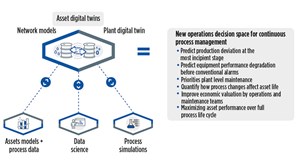
Similarly, at lower-flow conditions, compressors are more likely to get surge , resulting in increased energy usage and loss; poor process unit stability; control problems; seal or impeller damage; and machine failure. Trade-offs concerning equipment reliability exist around the pursuit of optimum flow, separation, energy consumption and related corrosion factors. This, in turn, impacts unit service factors, run lengths and turnarounds. For upstream producers, this involves balancing:
• Reservoir production profile changes over time (flow).
• Fluid composition (characterization) changes over time in terms of gas, oil and water.
• Flow assurance issues, such as hydrates, asphaltenes and wax.
• Asset management and life of asset issues, such as corrosion and scaling.
• Changing power demands (with increasing produced water), yet limited power generation flexibility.
• Right flow regimes and piping to control slugging.
• Type, size and cost of associated production and export facilities.
For these reasons, the coupling of asset reliability models with integrated asset process models for added operational context provides the key to maintaining the asset within optimal integrity operating windows. In doing so, one must balance the multiple factors involved in maximizing asset availability, Fig. 9.
CASE STUDY
A self-powered FPSO with processing capacity of 90,000 bopd, 10-20 MMcfgd of fuel gas handling and treated water injection rates of up to 30,000 bpd was being fed by 20 wells. There were multiple production system constraints in the form of onboard power generation capacity, as well as compressor availability.
A rigorous integrated asset model, connected to the reservoir model, was built in a single environment. The integrated model represented the whole asset, not just individual components, e.g. from wellhead through topsides facilities, as well as power generation facilities. This was done in order to evaluate changes made in isolated parts of the asset and how these collectively impact performance of the entire asset. The integrated asset model had consistent thermodynamics/flash calculations (incl. rating and costing) of equipment throughout, thereby ensuring right-sizing for all future anticipated operating scenarios. This also includes native integration of specialized models (such as heat exchangers, pipelines and risers, multi-phase and electrolyte thermodynamics, aqueous corrosion models, and cost estimation tools), thereby allowing for detailed design of the individual components without breaking their dependence on all the other assets, to assure most efficient and best possible design.
With all these components in one single environment and modelling of engineering workflows, data transfer among its various components was seamless and invisible to the user—there was no need to use multiple technologies to solve individual pieces of the problem. This process reduces errors and the time involved in jumping between different products and cutting and pasting data from one to the other.
VALUE DELIVERED
The integrated asset model, operationalized with real-time production data, was able to match well deliverability constraints to topside power generation and compressor availability constraints without any additional capital expenditure. This matching of constraints boosted FPSO production by 9,000 bopd, which at today’s prices equates to $400,000 per day of incremental revenue—achieved by a single integrated asset model/digital twin. Using only onboard equipment and zero additional capital expenditure, sub-surface to surface pressures were matched, along with, flows and power-production balance.
While this integrated asset model/digital twin was built on-premise, with the permission of the asset owner/operator, it could easily have been implemented in the Cloud. In this case, the asset owner/operator would have been able to start its remote operations center journey through achievement of remote surveillance/optimization from a remote optimization center.
This approach delivers significant incremental profitability. However, often it goes without merit. Measurement, monitoring and benefit reporting is lacking to provide awareness and visibility. As a result management recognition is lacking. This can be addressed by making the same models used by operations teams available to the C-suite through new intuitive user interfaces / dashboards with advanced logic that enable expert uses for less expert users. In this way alignment of leadership objectives to management, engineer and operator targets (top-down) can be achieved. These dashboards “hide” the complexity of the various underlying sub-models yet maintain the immense power and fidelity of the answers they deliver. The sub-models are used to update a series of business and financial key performance indicators (KPIs) that are updated in real-time, plan versus actual, as part of senior management’s balanced scorecard for corporate situational awareness.
REFERENCE
- https://www.mckinsey.com/industries/capital-projects-and-infrastructure/our-insights/resetting-capital-spending-in-the-wake-of-covid-19
- Advancing offshore decarbonization through electrification of FPSOs (March 2024)
- Digital transformation/Late-life optimization: Harnessing data-driven strategies for late-life optimization (March 2024)
- The reserves replacement dilemma: Can intelligent digital technologies fill the supply gap? (March 2024)
- What's new in production (February 2024)
- Digital tool kit enhances real-time decision-making to improve drilling efficiency and performance (February 2024)
- U.S. operators reduce activity as crude prices plunge (February 2024)
- Applying ultra-deep LWD resistivity technology successfully in a SAGD operation (May 2019)
- Adoption of wireless intelligent completions advances (May 2019)
- Majors double down as takeaway crunch eases (April 2019)
- What’s new in well logging and formation evaluation (April 2019)
- Qualification of a 20,000-psi subsea BOP: A collaborative approach (February 2019)
- ConocoPhillips’ Greg Leveille sees rapid trajectory of technical advancement continuing (February 2019)

